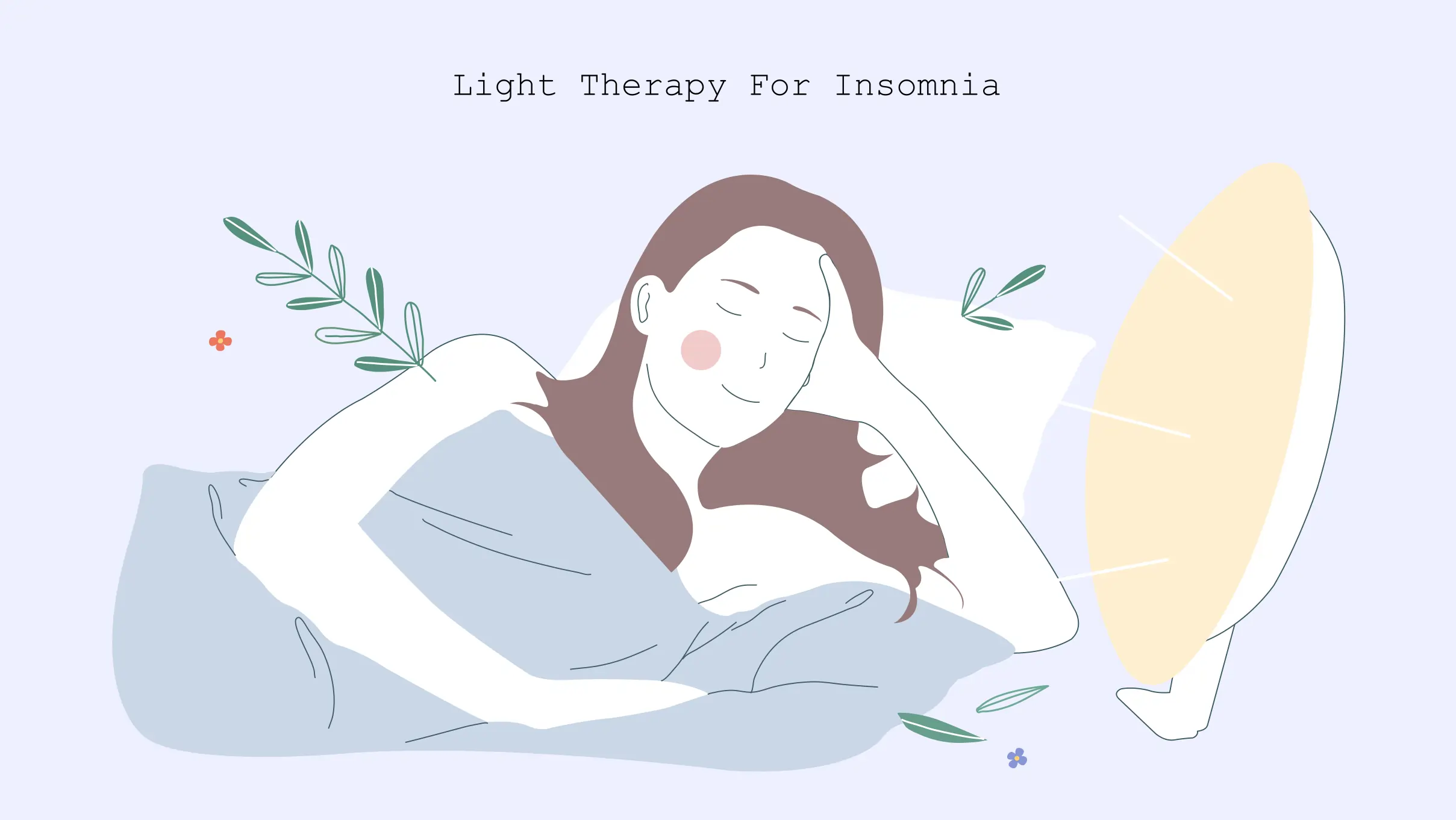Things Everyone Knows About Light Therapy for Insomnia
Written by


You must’ve had your best sleep in darker rooms, but did you know that light can also help you sleep better? It’s true! While you might prefer the calm of pitch-black, light gives you a similar buzz. This connection between light and deep sleep runs more profoundly than you think!
Sleeping in complete darkness isn’t feasible for people suffering from depression, anxiety, and other mental health disorders. This is where light therapy for insomnia comes in! It helps counter problems like circadian rhythm sleep disorders, insomnia, seasonal affective disorder (SAD), and depression.
In this article, we’ve further explored what light therapy is, its execution, its effectiveness against light disorders, side effects, and much more. So read on to acquaint yourself with bright light therapy for insomnia comprehensively.
What Is Light Therapy?
Light therapy for insomnia in older adults is the deliberate use of sunlight to treat common sleep disorders. It is also known as bright light therapy, circadian light therapy, light exposure therapy, or phototherapy.
During the therapy session, the individual sits in front of a specially designed light box that works with 10,000 lux. The induced light is substantially less than the sun and does not harm the eyes.
The treatment is especially beneficial for people suffering from:
- Circadian rhythm sleep disorder
- Insomnia
- Seasonal affective disorder (SAD)
- Mood disorders
- Jet lag
- Depression
- Alzheimer’s disease or dementia
- Working an overnight schedule
How Does Light Therapy Work?
We know what light therapy is, but how to use light therapy for insomnia or other similar disorders? In practice and understanding, light therapy is fairly easy!
You must sit in front of a specialized light box or visor created for therapy for some hours each day. The light should not be shone directly on the eyes to avoid damage. Instead, these boxes are intended to reflect intense light that resembles sunlight but without the presence of harmful UV rays.
It is recommended to keep the light intensity at 10,000 lux with the box sitting 16 to 24 inches away from the face. With this intensity, the session is expected to last around 20 to 40 minutes – longer sessions mean more benefits. This method would reset your circadian rhythm, i.e., your body clock, and restore your body cues of sleep and wake-up.
How Effective is Light Therapy?
Light therapy isn’t a complete cure for insomnia or other sleep disorders. So, how effective is light therapy? It eases the symptoms, gives you more energy, and increases your well-being. A slight difference in your sleeping ability will occur within a few days, but for some people, it can take up to 2 weeks.
Moreover, light therapy might only work for some. So, you can take specific steps to ensure it becomes more likely to work for you. For instance, ask your doctor to suggest some light boxes that work for your body. Furthermore, you can add psychotherapy to the sleep restoration process if your thoughts keep you awake. Also, be consistent with your sessions, even on days when you don’t have to get up on time.
Other methods you can try are:
- Dimming lights during bedtime.
- Avoiding phones, computers, and TV before bed.
- Not exercising for one hour before bed.
- Trying to get as much sunlight as possible during the day.
What About Sunlight?
Besides the lightbox, it is also possible to use the sun for light therapy. The alternative works if your end goal is to reset the circadian rhythm and match your schedule with the natural light cycle (sunrise and set).
If your job, work, or the day, in general, involves being under sunlight or sitting near the window, then it can be a viable replacement for the lightbox. However, in most cases, a lightbox is recommended because of its efficiency and absence of UV rays. Moreover, with the lightbox, you can maintain a consistent schedule, even if there is no natural light outside.
Other Conditions Light Therapy May Help
There are several circumstances under which light therapy can prove effective. It can be anything, from an altered sleep cycle and genetic abnormalities to medical conditions, jet lag, and late-night exposure to digital devices.
Following are all the conditions where light therapy can prove effective:
Circadian Rhythm Sleep Disorders
There are several sleep disorders caused by circadian rhythm disruption, including:
- Delayed sleep phase disorder
- Non-24-Hour Sleep-Wake Disorder
- Shift work sleep disorder
- Irregular sleep-wake rhythm disorder (rare)
- Advanced sleep-wake phase disorder
- Jet lag
Light therapy is recommended as the primary treatment for all of these circumstances. A 2015 study shows the use of scheduled light and melatonin for improving sleep hygiene and countering the disorders.
Jet Lag
Traversing several time zones can also disrupt the sleep cycle as your body remains synchronized with the old time zone. It can easily be cured by stepping outside during the day and letting your body get used to the new time. However, light therapy can help accelerate it and restore balance.
Seasonal Affective Disorder
Seasonal affective disorder (SAD) is a type of depression that occurs with changes in seasons. It is believed to come in fall or winter owing to the lack of sunlight. Shorter days disrupt the wake-sleep cycle and impact the chemicals serotonin and melatonin.
Inducing artificial light through light therapy, people suffering from SAD regain the semblance of light in their regular cycle. Research also suggests it can help improve symptoms or even counter them altogether.
Depression
Even if you’re not suffering from seasonal depression, you can still experience sleep issues. While no evidence suggests its effectiveness, light therapy can still benefit non-seasonal depression.
Are There Side Effects to Light Therapy?
As beneficial as it is, are there side effects to light therapy? While the procedure is safe, some individuals can experience side effects like itching eyes, nausea, headache, skin irritation, and hyperactivity. The side effects tend to go away after a few hours, but if they don’t, it is best to consult a doctor.
Can You Do Light Therapy at Home?
The reason why light therapy appeals to the masses is because of its accessibility. You can conduct it right at home. Its components are readily available and inexpensive, and you can conduct it while reading, writing, talking, or using your phone.
The lightboxes come in different shapes and sizes, like:
- Floor lamps
- Tablet-like devices
- Table lamps
- Desk lamps
- Wearable visors
- Alarm clocks
Remember that each lightbox is designed to serve a specific sleep disorder – a lightbox for seasonal affective disorder will differ from one for depression. So, based on your requirements and the kind of sleep disorder you’re suffering from, you can select your lightbox.
Conclusion
With changing lifestyles and hectic schedules, insomnia is becoming rampant among individuals. Instead of fervently wishing for sleep, you can cure it with light therapy. You can easily procure a lightbox and carry the procedure right at home. Just be cautious while using the equipment, and look for any side effects!
FAQs
Does bright light therapy work for insomnia?
In general, light therapy helps with sleep issues, especially circadian issues and insomnia symptoms. The majority of effect sizes, though, are small to medium.
How long does it take light therapy to work for insomnia?
Although it can help with your symptoms, light therapy is not a cure for sleep disorders. Additionally, it may increase your vitality and sense of well-being. It might take two weeks or longer, but you might notice a difference in just a few days.
Can I use light therapy all day?
Individuals participating in light therapy must spend 20 to 30 minutes each day seated in front of the lamp (about 14 to 24 inches away from their face). Researchers advise against exceeding 30 minutes per day. As a result of the light therapy, your brain produces more serotonin and less melatonin, which lifts your mood.
When is the best time to use light therapy?
Beginning light therapy as soon as you awaken in the morning is ideal (between 6:00 a.m. and 9:00 a.m.). The typical response begins within a few days, and the symptoms should unquestionably improve by two weeks. However, most patients must continue receiving light therapy through the winter and spring.
How do you do light therapy at home?
Choose the proper lighting, avoid staring at it, keep the box a foot or so to the side, and take your time. Starting in the morning, you should absorb the light from your lamp for about 30 minutes daily.
people like this article
Written by








